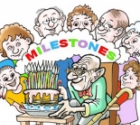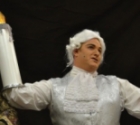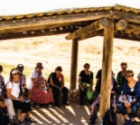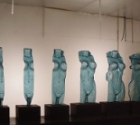
On the stairs leading to the Piazza del Quirinale
A personal view of the city
At the pedestrian crossing, the oncoming motorist must have been watching me carefully and his calculation to miss me by several centimeters proved correct. I notice that some drivers even wait to see who hesitates first. If you are determined to cross, they stop. However, don’t take my word for it: Rome has a high accident rate! At all hours we hear the squealing of ambulances and police cars, a background noise that is usually ignored.
We experience something unique – on the outskirts of the city is a crossing (a pedestrian traffic light followed by white stripes on the road), which leads to a halfway point where several roads intersect. At this mid-point is a small platform to stand on, and that’s it – you’re stuck in the middle of the road (someone obviously didn’t think this one through). We are left with one of two choices: either to go back the way we came or to dodge across the rest of the street – we choose the latter.
The best way to cross the road seems to be the method we saw in Istanbul: wait until a number of people gather and then, in a determined “square”, all cross together.
Nevertheless, Rome is a friendly city, and good to walk through, but you must be careful of that large central area of “tourist” Rome, especially if you have children with you. In this case, I chose to be behind our group – keeping an eye on three grandchildren (two batmitzvahs “to come”, and one barmitzvah “that was”).
There is something about the streets, lit up for Christmas, which gives one a friendly feeling, whether we walk along the wide pavements leading from the Piazza Navona (next to our new “home”) to the Coliseum, or in small cobblestone streets with no pavements which wind between Five-story houses built from the 16th century onwards. Unlike Paris, London, New York, and other cities we’ve visited, there is a sense of “togetherness” when walking in Rome, as if we all belong to one big family.
And everything is in good taste – especially the shops (the two girls stop at every second or third shop, fascinated. If you’re not careful, you can overstep the budget for the entire holiday in the first few days).
Part of our luck was finding a reasonably priced flat in the historic quarter – near the Tiber and a short walk from Piazza St. Pietro. Few cars come along these twisting cobblestone alleyways, and pedestrians have the right-of-way. The occasional car waits patiently until it is recognized and the walkers let it pass.
There are 90 steps to negotiate to get to our fifth floor flat (the first two floors, built in the 17th century, have high ceilings) but we don’t get upset. These steps, not as high as those we are used to in Tel Aviv, also seem to go up at an angle of less than 45 degrees. A short struggle to open the heavy front door, and we enter the foyer of a warm flat: two large rooms, a long corridor which leads to the fully-equipped kitchen and bathroom, and hot water available at all hours.
The first day is a disaster (Saturday December 8). We are tired; outside it is 8ºC and an icy wind is blowing. The flat, with radiators in every room, is still cold – nothing was switched on until shortly before we arrived. By the second day, however, the outside temperature rises to 10º and we feel comfortably warm. Then it goes up still further to 11º. Really hot!
Walking the streets, Elia, a quiet, studious boy (plays violin and football, a great reader and some sort of belt in judo) begins to sing. At first, I’m embarrassed, but I sing along with him, and suddenly we are “part of the furniture”. No one even notices.
Small eating-places are everywhere. Not far from home we enter an unusual pub and tearoom: simple wooden floors, deliberately mismatched chairs, rock music – outside are three tables, each with a chess set: Elia is playing against the girls. I come out to have a look, give a bit of advice to the girls, which they follow, and Elia makes his next move – checkmate. “Thanks Saba”!
Rome is a city of colorful buildings. We pass walls of red brick, deep terracotta, burnt sienna, creamy gold, pale pink, buff yellow and orange. It is early evening, but already getting dark. The Christmas lights strung along the streets, outside the buildings, and on some Christmas trees go on, and we join the throngs of people watching street performers.
Piazza Navona, to which we always return after making our respective “loops” (each day choosing a different direction and exploring interesting buildings on our way), is a large square, with three fountains by Bernini. Once used for horse races and tournaments, today the square has become a lively center of lights, music, shops, stalls, displays, a free merry-go-round, sweets, and crepes made on the spot (with Nutella smeared on top). Among the artists sitting in the square is a man with an Asian face, selling outsize insects (grasshoppers and so forth) made out of long blades of grass. We buy a few and afterwards find out that the beauty and precision of his work are amazing. We want to buy more, but although we pass here every day, we never see him again.
In the middle of the square, represented by gigantic statues of four seminude males, is the fountain of the four rivers: the Nile, the Ganges, the Danube, and the Rio de la Plata. The last-named statue holds up one hand in horror to protect himself from the dome of the nearby church of St. Agnes, which seems about to topple onto him – legend has it that this is Bernini’s private joke against his rival, Francesco Borromini, who built the dome.
Next day, walking in a light rain, we aim for the Pantheon, now a church. This spacious building is more than 2000 years old and is topped by a great dome, the first ever built. High above us, in the center of the dome, is a large round opening: the oculus. When it rains the water falls through and is absorbed in tiny fissures in the floor below – so I read. When the sun shines, the rays come through the oculus like a moving eye of light.
We carry small umbrellas but hardly ever open them – this is rain? At the baroque fountain of Trevi, where streaming cascades burst from under the massive rocks which seem to support the palatial building behind it, Elia has his first run-in with the police – he climbs up the rocks. This gives the policeman the chance to blow his referee’s whistle: he does this, and the Israeli rock-climber comes down after I explain the matter to him.
We walk across town to the Coliseum, but by the time we get there, we can’t go inside – at 15:30 the ticket office closes. It takes us three days before we actually get inside – well, what can you expect if the youth insist on going to bed at midnight and wake up late in the day. We are uptight at first, but remember that, after all, this is their holiday.
From the top of the tomb of the Unknown Soldier, we have another spectacular view of Roman hills, churches, and domes. The massive building contains a war-type museum. The street circling this monument is a favored spot for passing motorists to reveal their tourist-scaring skills, and crossing it demands strict attention.
Lower down along the road are the Forum and the Coliseum, the latter having five levels of arches, though not many remain at their original height. It looks spectacular from the outside, but the interior is a disappointment for anyone who’s seen the coliseum the Romans built at Al Djem in Tunisia, which is in a far better state of preservation.
For a change, we get to see some art. Amazingly, the kids are interested. Once you give a child a camera, it seems, you’ve helped to create an artist. From that moment on everything around becomes a subject.
The Scuderie del Quirinale is holding a Vermeer exhibition, which also features other Dutch painters of the 17th century. Of course, the Girl with the Red Hat takes pride of place; but for me the view of Rome with its lights flickering on) from this hill-top museum, was of greater interest.
Back home in the warm flat, grandmother makes soup, the girls talk to their respective parents on their cell phones, and the boy practices his violin, which he has brought with him. Outside, a strong rain is falling, but soon dies down to a drizzle. After dinner, Elia conducts us in a sing along using a long breadstick as a baton.
Another day
The Santa Maria Maggiore is an awe-inspiring church. I still remember that Christmas 12 years ago when it was packed with people, and the singing was superb – like being at the opera. Italian is a singing language. Words are accentuated on the penultimate syllable, followed by a soft feminine ending. I wonder if there is another language that sounds as melodious.
Elia has decided what to buy with the budget his grandmother put aside for him: in one of the many well-equipped and well-lit bookstores, he finds a book of Japanese prints, which fascinates him. The book is coffee-table size and weighs more than three kilos. Carrying it while walking the city presents certain difficulties, but he is a strong lad. Thereafter he spends evenings copying those prints he likes. There are extensive essays on each period, but they are in English; he is a determined person and one day – who knows – he’ll read them.
On Friday night we go to synagogue in the Jewish quarter and hear the wonderful singing of the cantor.(A story of the Jewish quarter appears on page....).
Our one trip outside Rome is to the Can Callisto catacombs - (there are many such catacombs outside the encircling walls of old Rome). Four levels down, along long, straight passages, we pass thousands of deep, empty niches cut in the rock walls soaring above our heads. Unfortunately, our guide’s English is not easily decipherable, in addition to which he is in a hurry to get out, and we don’t fully take in the atmosphere of this underground city of the dead.
Outer Rome is not so attractive: crammed flats in long buildings, but nevertheless with aflair. However – not for tourists! But whenever you feel hungry there are always good places to eat.
The last day in Rome, I missed out on going to the renovated Vatican museum – a place I remember as being crowded with works of art. However, I was getting internal signals of distress, and had to remain anchored to the house. This leads to the following words of caution.
The Romans look pretty healthy on the local diet - pizza with thick layers of yellow cheese (outstanding), a choice of 150 flavors of gelati followed by good, strong coffee. But if you are not used to this sort of thing (especially if you’re pushing 80), it's wisest not to overdo it!
On our third day in Rome, Elia mentions that he would like to live here. And after we return to Israel, Tamar cries that she misses Rome, especially the lively lit-up Piazza Navona and the Trevi fountain. Elia’s choice is the historic quarter where we stayed – the cobblestone streets, the ambience, and the clean air. Lia proves to be a combination – she likes the old streets and buildings, the fountain “where we threw in the coins” and, of course, the Piazza Navona.

At the Ara Pacis Museum
 Milestones 168
Milestones 168 “Be our Guest” at Beauty and the Beast
“Be our Guest” at Beauty and the Beast Advertisers List
Advertisers List From Bible to Bedouins and Battles
From Bible to Bedouins and Battles Trip to the Dead Sea
Trip to the Dead Sea Japan
Japan Mike Porter
Mike Porter